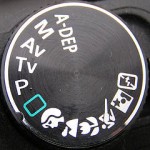Be a Control Freak, Part II

Being an excellent photographer is 50% vision and 50% technical prowess. Seeing the art all around you is only useful for the photographer who can capture it, and perfectly executing that capture means wrangling the piece of hardware you love so much, the camera.
These days, most photographers are shooting digital. Digital photography is freeing in a lot of ways, but it is also more complicated. Camera manufacturers have sought to close the gap between the pro and the semi-pro by providing all of these different shooting modes, and even though I still believe you only need three, it’s not unusual to see mode dials with 11 or 12 settings on them! You don’t need all those settings to get full control! Haje Jan Kamps helps me explain after the break.
I’ve written about this before in Be a Control Freak (Shooting Modes Explained), but the subject came up again today when I saw Haje Jan Kamps’ really cool article, Translating the mode wheel on pixiq. My article explains in some amount of gory detail what each mode does, Haje takes it a step further with example images and a plea to leave those silly program modes behind.
Haje says:
This little dial is called your mode wheel, and it’s your mortal enemy, the destroyer of creativity, and the root of all evil in the world including, but not limited to, wars, swine flu, and stepping in chewing gum with a new pair of shoes.
Definitely hop over to pixiq and read Haje’s article, check out my previous article if you haven’t read it before, and if you are hankering for even more information…
Learn Tips and Tricks for Real-Life Shooting

These three books are among the most straightforward guides to the real-life application of camera settings in a broad variety of situations that I’ve come across. They’re written by Scott Kelby, the publisher and editor of Photoshop User and Layers magazines, president and co-founder of the National Association of Photoshop Professionals, and founder of the eponymous training website (kelbytraining.com).
He’s written over 40 books. I haven’t read them all, but I’ve read these, and they’re awesome. They’re short, not too expensive, presented in plain language, and useful to photographers at nearly any skill level. The three books don’t progress in skill level or detail, they are simply three chapters of the same overall plot, so you can snag the one with the prettiest cover, flip a coin, or just buy all three.
Here are the three individual books, they’re each about 25 bucks or less, I think the second volume is the cheapest:
- The Digital Photography Book, Vol. 1
- The Digital Photography Book, Vol. 2
- The Digital Photography Book, Vol. 3
Or get them all together in this B&H kit. I think you save about $1.50, so I guess the kit is offered for convenience, but hey, convenience has gotta be worth something, right?
They’re really swell books, and I don’t usually jump on the bandwagon when it comes to these sort of corporate “training mill” publishers but Scott knows what he’s talking about and presents it in a very clear way so I’d be doing you all a disservice not to recommend them to you.
Moreover, if you click through these links here, you get the same books for the same prices you would pay if you went straight to B&H’s website yourself, but I also get a tiny little commission that helps me keep this site online, so if you are even remotely thinking about picking up a book or two, please use these links and help me out.
 Single-Serving Photo
Single-Serving Photo
Comments